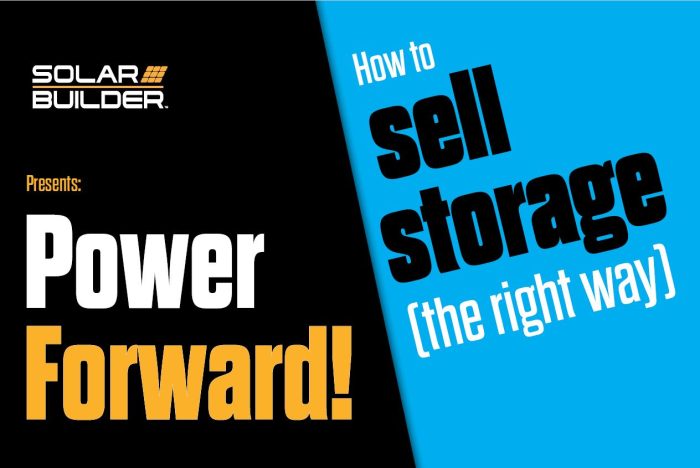
Pairing energy storage with home solar is more important than ever – but selling and designing a system that meets a customers’ needs – and fits their budget – is not easy. Today on Power Forward! we learn how to start selling energy storage the right way with Aaron Bingham and Blake Akin from BayWa r.e. We discuss …
0:33 – Common problems selling energy storage five years ago
3:26 – What are those absolute first steps to take before selling energy storage products?
5:05 – Tips for marketing ESS and the power of brand familiarity
6:40 – Energy storage systems that stand out right now
9:12 – Key differences from a solar-only sale
10:48 – How to handle the “whole-home backup” expectation
13:42 – How to handle the longer sales process?
15:16 – The impact of main panel upgrade avoidance
16:00 – Preparing customers for the future of the all-electric home
Watch the full episode right here or read through part of the transcript below.
Crowell: I had heard from several installers while [at the NABCEP conference] who mentioned they had tried to start selling battery storage systems five years ago, and it was a disaster for various reasons. Now they are trying to get back up to speed. What have you heard from your installer customers who had early struggles adding energy storage?
Akin: A lot of it is the economics. The sticker shock was a big issue and also a little bit about being educated on what energy storage is. In a lot of cases — especially five years ago — it was not seeing the need for it or not understanding the need for it. They just didn’t really dive into the economic piece of it as much as they are today.
Bingham: It was also a lot more expensive for different companies to integrate energy storage sales into their sales dynamics, into their installation dynamics. The system has to be usually sold by one person, and that’s not always the same person who designs the system. And with the way that energy storage is perceived on the market versus the way it was actually operating five years ago, there was likely to be somewhat of a disconnect there.
Another challenge at that time, a lot of these solutions were relatively new, and new solutions often have frequent firmware updates. There are often lots of challenges that come with deploying a new solution in the real world that inevitably will lead to some lessons being learned about what the system is capable of and how that should be described and sold.
We certainly saw some challenges on the service front too. That was another element of the way in which adding energy storage to your business as a solution may have been perceived as something that’s going to be increasing your costs. There’s also greater need for specialized labor on site during the installation of energy storage in some cases, depending on how the system is being designed and installed.
Crowell: At the very beginning, what are the absolute first steps to take or questions to ask before adding energy storage as a product offering?
Akin: What’s really important is to know the market and know your customer and understanding what they’re needing before offering anything. Just rushing in and overwhelming the customer with all these battery options, it could be messy. It could be very difficult to sell. Pare it down and make it really easy for the customer, and the way to do that is to ask questions.
Bingham: Invest some time in the resources that energy storage manufacturers have developed on the training side of things as well. It’s a good idea to be certified before you’re selling the product and even before you decide to ask your sales team to offer the product because there are things that you learn during the certification process about the way the system will operate, about the promises that can be made during the sales cycle, that are going to be really important bits of information for the sales team to be aware of as they’re out there pitching it.
Crowell: So, when I am promoting, ‘hey, I have energy storage as a solution now,’ what are some things to be mindful of when I’m doing that promotion?
Bingham: One thing we’re still learning more about out there is the importance of brand familiarity, especially for customers when they’re buying energy storage. There are huge brands like Tesla that customers know very well, and they kind of set the standard around what customers expect with these systems. And there are new players out there that have really interesting, strong products and are working hard to build their brand out. We’re still learning what role brand familiarity plays, but I would expect that some element of brand familiarity does give folks that are actually in the home trying to make the sale somewhat of a leg up.
Akin: Different battery storage systems offer different things, so when we understand what the customer is wanting, in some cases it could be economic, in some cases it could be for having storage when there are power outages. So, understand that and educate the customer on what these systems can provide, and then set clear expectations on what they can do.
Pick up the conversation right there, with their view on which ESS systems stand out in the market right now:
— Solar Builder magazine

Leave a Reply
You must be logged in to post a comment.